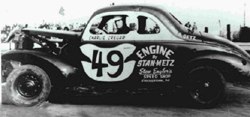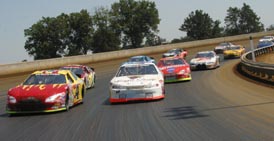|
Stock car is used to differentiate a special race car, custom-built and designed only for racing purposes with no intent of its ever being used as regular transportation. In the beginning, stock-car racing was exactly what it sounds like. Drivers actually bought brand-new cars from dealers and went racing.
 The original races were run on dirt tracks that got rutted and bumpy. The unmodified cars were not tough enough for this type of abuse, so NASCAR began allowing modifications to the stock cars to increase their durability but strictly controls all of these modifications, which are spelled out in detail in the NASCAR rule book. Cars are checked for compliance with these rules at every race. The original races were run on dirt tracks that got rutted and bumpy. The unmodified cars were not tough enough for this type of abuse, so NASCAR began allowing modifications to the stock cars to increase their durability but strictly controls all of these modifications, which are spelled out in detail in the NASCAR rule book. Cars are checked for compliance with these rules at every race.
The National Association for Stock Car Auto Racing (NASCAR), was organized in 1947, and created a standardized set of rules for stock-car racing and established a system for selecting a national champion based on performance at races across the country. Before NASCAR was founded, moonshine runners during the prohibition era would often have to outrun the authorities. To do so, they had to upgrade their vehicles and eventually started getting together with fellow runners and racing. They would challenge one another and this eventually progressed to organized events.
 Today, NASCAR race cars have very little in common with street cars. Almost every detail of a NASCAR car is handmade. The bodies are built from flat sheet metal, the engines are assembled from a bare block and the frame is constructed from steel tubing. Today, NASCAR race cars have very little in common with street cars. Almost every detail of a NASCAR car is handmade. The bodies are built from flat sheet metal, the engines are assembled from a bare block and the frame is constructed from steel tubing.
The tracks are usually oval rings of a quarter-mile in length, but also raced occasionally on road courses. Ovals shorter than one mile are called short tracks; unpaved short tracks are called dirt tracks; longer ovals are typically known as superspeedways. Top level races are generally 200 to 500 miles in total length. |